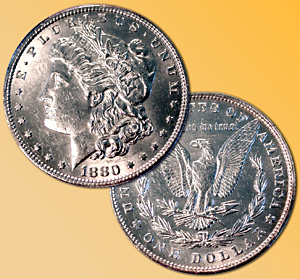George T. Morgan's Fabulous Silver Dollar
|
"Making Cents"
The Signal
Saturday, August 6, 2005
| O |
They were made at the mints in Philadelphia each year; in Carson City several years between 1878 and 1893; in New Orleans every year from 1878 to 1904; in San Francisco every year of issue; and in Denver only in 1921.
These large silver coins were made of .900 fine silver and weighed 412.5 grains (about three-fourths of an ounce). They have a nice, solid ring when bounced on a hard surface, and they often were featured in old Western movies.
The design by George T. Morgan was a stylized, full-faced Miss Liberty with a liberty cap and headband embossed with the word, "LIBERTY." The eagle, with its wings spread upward and out, featured a trio of arrows in its left talons and an olive sprig in its right talons, symbolizing both strength and peace. The mint mark, when there was one, appeared directly below the eagle¹s tail feathers.
Most Americans became familiar with the silver dollars at Las Vegas casinos in the 1950s and up to the early 1970s. Before then, the coins saw little use outside of Montana, Nevada and smaller Western cities and towns. In fact, many banks in the East returned the coins to the local Federal Reserve branch rather than issue them to customers ‹ who rarely asked for them.
The unused silver dollars from the various mints wound up in the Treasury vaults in Washington, D.C., over a period of decades, and in the early 1960s the General Services Administration decided to sell off these coins, as they were taking up valuable space and not bringing in any money to the Treasury.
Many bags of 1,000 coins were eventually sold at face value to customers who would line up at the Treasury building. Some bags contained mint-state coins from the branch mints of New Orleans, San Francisco and Carson City ‹ as well as coins that predated the Morgan dollar, and later issues of the Peace dollar.
Eventually the GSA decided to sell the Carson City dollars at various prices depending on their relative scarcity, from $15 to $300 each. These black-encased coins are very popular with collectors today; the most common dates ‹ 1882-CC, 1883-CC and 1884-CC ‹ bring about $200 each.
One of the best-known hoards of silver dollars was the LaVere Redfield hoard of 400,000 coins, mostly mint condition, found sealed behind a false wall in his basement.
The bachelor Redfield had lived near Reno for more than 70 years and hoarded these coins. After his death, the county court disposed of the hoard at an auction in 1976 for more than $7 million. The successful bidder split the hoard among several dealers.
These pieces, later encased in small, red plastic holders, are known simply as "Redfield dollars." They vary widely in price depending on the date, mint mark and condition.
Much smaller hoards are known, especially with persons who frequented Las Vegas casinos in the 1950s to Œ70s. There are many low-mintage coins in the series, and today, in mint state, quite a few are worth well into the five- and six-figure price ranges. Among the most sought-after dates are 1879-CC, 1893-CC, 1893-O, 1893-S, 1895, 1895-O and 1901 in mint condition.
The 1895 coin is rare, although there are more proofs available than business strikes. It is believed that the bulk of the 12,880 pieces minted were lost at sea in a shipment from Philadelphia. A bright mint-state coin could fetch more than $100,000 at auction. A nice proof specimen of similar grade would usually bring less than half of that amount.
In addition to these popular rarities, there are many well-recognized varieties known to collectors as "VAMs," from the original authors of the variety guide, Leroy Van Allen and George A. Mallis. In many cases, some VAMs exceed the other silver dollars in value due to their great rarity; in some cases, fewer than a dozen uncirculated pieces are known, such as the VAM-44.
There are several silver dollar guide books devoted just to the Morgan dollar, and some just to the varieties in the series.
Finally, to those old enough to have survived the Great Depression, the Morgan dollar was a highly popular birthday gift for the youngster turning 10 or 11 in the 1930s. Perhaps Grandpa has a few put away from the years his own grandparents gave him one or more while he was growing up.
Dr. Sol Taylor of Sherman Oaks is president of the Society of Lincoln Cent Collectors and author of The Standard Guide to the Lincoln Cent. Click here for ordering information.
©2005, THE SIGNAL · ALL RIGHTS RESERVED.
